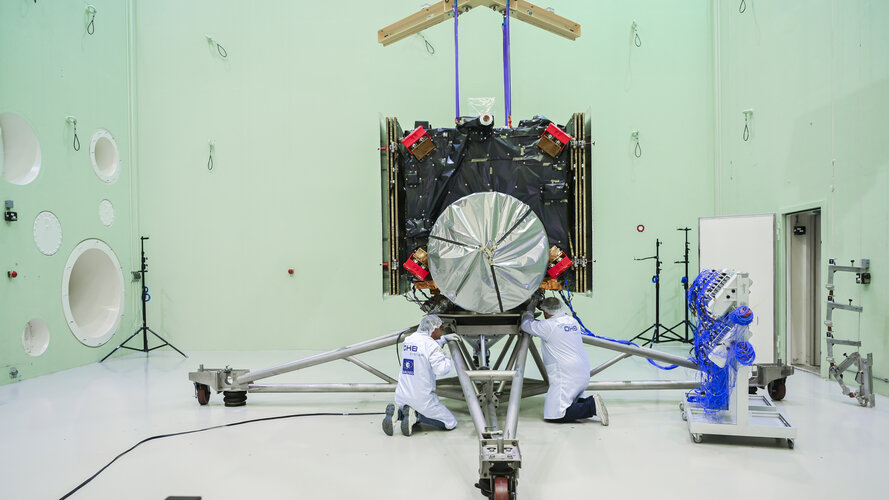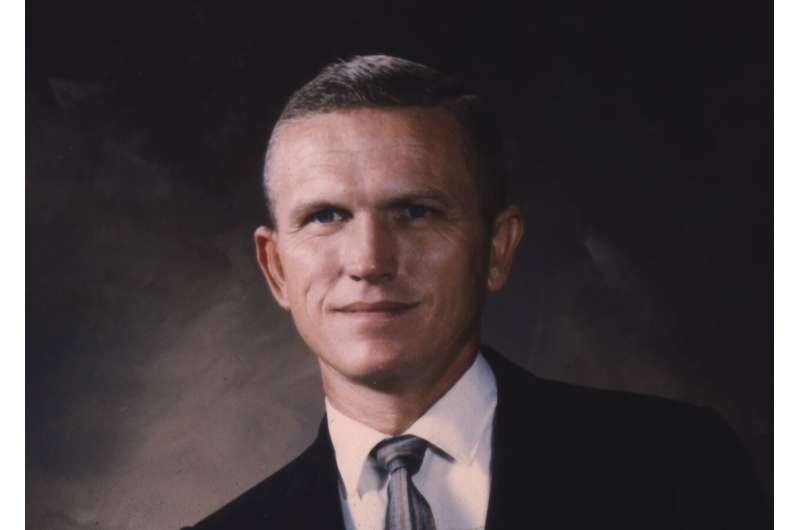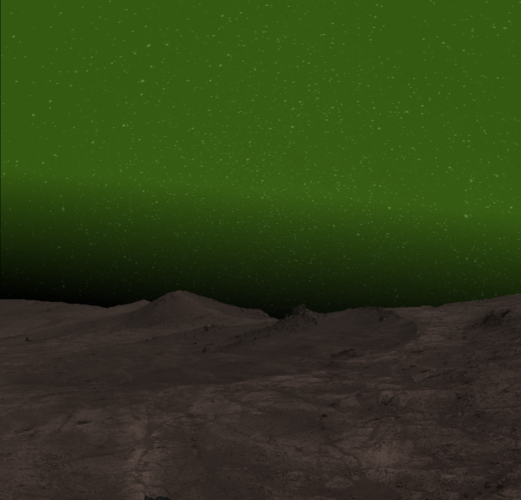
Copernical Team
Friday, 10 November 2023 11:28
Hera asteroid mission hears the noise

ESA’s Hera asteroid mission has completed acoustic testing, confirming the spacecraft can withstand the sound of its own lift-off into orbit. Testing took place within the Agency’s Large European Acoustic Facility at the ESTEC Test Centre in the Netherlands. This is Europe’s largest and most powerful sound system, fitted with a quartet of noise horns that can generate more than 154 decibels of extreme noise.
Published in
News
Tagged under
Friday, 10 November 2023 08:31
Terran Orbital Unveils Advanced Enterprise Satellite Buses for Next-Gen Space Missions
Los Angeles CA (SPX) Nov 10, 2023
 Terran Orbital (NYSE: LLAP), a trailblazer in satellite technology, has expanded its innovative product line with the introduction of two new configurations of the Enterprise-class bus, supplementing its standard product offerings initially launched last September. This latest announcement from Terran Orbital introduces configurations that promise to redefine the benchmarks for satellite technol
Terran Orbital (NYSE: LLAP), a trailblazer in satellite technology, has expanded its innovative product line with the introduction of two new configurations of the Enterprise-class bus, supplementing its standard product offerings initially launched last September. This latest announcement from Terran Orbital introduces configurations that promise to redefine the benchmarks for satellite technol
 Terran Orbital (NYSE: LLAP), a trailblazer in satellite technology, has expanded its innovative product line with the introduction of two new configurations of the Enterprise-class bus, supplementing its standard product offerings initially launched last September. This latest announcement from Terran Orbital introduces configurations that promise to redefine the benchmarks for satellite technol
Terran Orbital (NYSE: LLAP), a trailblazer in satellite technology, has expanded its innovative product line with the introduction of two new configurations of the Enterprise-class bus, supplementing its standard product offerings initially launched last September. This latest announcement from Terran Orbital introduces configurations that promise to redefine the benchmarks for satellite technol
Published in
News
Tagged under
Friday, 10 November 2023 08:31
SES Space and Defense Secures DoD Medium Earth Orbit Services Contract
Los Angeles CA (SPX) Nov 10, 2023
 SES Space and Defense, a subsidiary of the global satellite operator SES, recently secured a substantial contract with the U.S. Department of Defense (DoD), valued just shy of $270 million over a five-year span. This single award Blanket Purchase Agreement (BPA) underscores a pivotal shift toward integrating commercial satellite capabilities into the fabric of military communications, a move tha
SES Space and Defense, a subsidiary of the global satellite operator SES, recently secured a substantial contract with the U.S. Department of Defense (DoD), valued just shy of $270 million over a five-year span. This single award Blanket Purchase Agreement (BPA) underscores a pivotal shift toward integrating commercial satellite capabilities into the fabric of military communications, a move tha
 SES Space and Defense, a subsidiary of the global satellite operator SES, recently secured a substantial contract with the U.S. Department of Defense (DoD), valued just shy of $270 million over a five-year span. This single award Blanket Purchase Agreement (BPA) underscores a pivotal shift toward integrating commercial satellite capabilities into the fabric of military communications, a move tha
SES Space and Defense, a subsidiary of the global satellite operator SES, recently secured a substantial contract with the U.S. Department of Defense (DoD), valued just shy of $270 million over a five-year span. This single award Blanket Purchase Agreement (BPA) underscores a pivotal shift toward integrating commercial satellite capabilities into the fabric of military communications, a move tha
Published in
News
Tagged under
Friday, 10 November 2023 08:31
Northrop Grumman Finalizes Key Trials for Arctic Communications Satellites
Los Angeles CA (SPX) Nov 10, 2023
 Northrop Grumman Corporation (NYSE: NOC) has successfully completed a series of pivotal Thermal Vacuum tests on the Arctic Satellite Broadband Mission (ASBM), paving the way for enhanced broadband communications in the strategically significant Northern polar region. This two-satellite constellation is an integral component of a collaborative effort involving the U.S. Space Force and Space Norwa
Northrop Grumman Corporation (NYSE: NOC) has successfully completed a series of pivotal Thermal Vacuum tests on the Arctic Satellite Broadband Mission (ASBM), paving the way for enhanced broadband communications in the strategically significant Northern polar region. This two-satellite constellation is an integral component of a collaborative effort involving the U.S. Space Force and Space Norwa
 Northrop Grumman Corporation (NYSE: NOC) has successfully completed a series of pivotal Thermal Vacuum tests on the Arctic Satellite Broadband Mission (ASBM), paving the way for enhanced broadband communications in the strategically significant Northern polar region. This two-satellite constellation is an integral component of a collaborative effort involving the U.S. Space Force and Space Norwa
Northrop Grumman Corporation (NYSE: NOC) has successfully completed a series of pivotal Thermal Vacuum tests on the Arctic Satellite Broadband Mission (ASBM), paving the way for enhanced broadband communications in the strategically significant Northern polar region. This two-satellite constellation is an integral component of a collaborative effort involving the U.S. Space Force and Space Norwa
Published in
News
Tagged under
Friday, 10 November 2023 08:31
Momentus and RIDE! Space collaborate to connect SmallSat operators for In-Space Services
San Jose CA (SPX) Nov 10, 2023
 Momentus Inc. (NASDAQ: MNTS), a pioneer in the space transport sector, has announced a significant partnership with the Paris-based New Space company, RIDE! Space, aiming to streamline satellite launch services. This collaboration is set to include the deployment of Gaindesat and Djibouti payloads scheduled for a joint mission in 2024.
Since its inception in 2020, RIDE! Space has committed
Momentus Inc. (NASDAQ: MNTS), a pioneer in the space transport sector, has announced a significant partnership with the Paris-based New Space company, RIDE! Space, aiming to streamline satellite launch services. This collaboration is set to include the deployment of Gaindesat and Djibouti payloads scheduled for a joint mission in 2024.
Since its inception in 2020, RIDE! Space has committed
 Momentus Inc. (NASDAQ: MNTS), a pioneer in the space transport sector, has announced a significant partnership with the Paris-based New Space company, RIDE! Space, aiming to streamline satellite launch services. This collaboration is set to include the deployment of Gaindesat and Djibouti payloads scheduled for a joint mission in 2024.
Since its inception in 2020, RIDE! Space has committed
Momentus Inc. (NASDAQ: MNTS), a pioneer in the space transport sector, has announced a significant partnership with the Paris-based New Space company, RIDE! Space, aiming to streamline satellite launch services. This collaboration is set to include the deployment of Gaindesat and Djibouti payloads scheduled for a joint mission in 2024.
Since its inception in 2020, RIDE! Space has committed
Published in
News
Tagged under
Friday, 10 November 2023 08:31
Iridium Set to Directly Partner with OEMs Following Qualcomm Agreement Termination
McLean VA (SPX) Nov 10, 2023
 In a strategic shift that underscores the evolving landscape of global satellite communications, Iridium Communications Inc. (NASDAQ: IRDM), has announced an update to its partnership with Qualcomm Technologies, Inc., a subsidiary of QUALCOMM Incorporated.
The announcement comes in the wake of a previous agreement wherein Iridium and Qualcomm aimed to integrate satellite messaging and emer
In a strategic shift that underscores the evolving landscape of global satellite communications, Iridium Communications Inc. (NASDAQ: IRDM), has announced an update to its partnership with Qualcomm Technologies, Inc., a subsidiary of QUALCOMM Incorporated.
The announcement comes in the wake of a previous agreement wherein Iridium and Qualcomm aimed to integrate satellite messaging and emer
 In a strategic shift that underscores the evolving landscape of global satellite communications, Iridium Communications Inc. (NASDAQ: IRDM), has announced an update to its partnership with Qualcomm Technologies, Inc., a subsidiary of QUALCOMM Incorporated.
The announcement comes in the wake of a previous agreement wherein Iridium and Qualcomm aimed to integrate satellite messaging and emer
In a strategic shift that underscores the evolving landscape of global satellite communications, Iridium Communications Inc. (NASDAQ: IRDM), has announced an update to its partnership with Qualcomm Technologies, Inc., a subsidiary of QUALCOMM Incorporated.
The announcement comes in the wake of a previous agreement wherein Iridium and Qualcomm aimed to integrate satellite messaging and emer
Published in
News
Tagged under
Friday, 10 November 2023 08:31
ESA Embracing Commercial Space Stations with Airbus and Voyager Space Partnership
Paris (ESA) Nov 10, 2023
 In a significant step toward ensuring Europe's continued presence in low Earth orbit, the European Space Agency (ESA), in partnership with aerospace titan Airbus and space infrastructure pioneer Voyager Space, has penned a Memorandum of Understanding (MOU) for the development of the Starlab space station. This collaboration was spotlighted during ESA's Space Summit in Seville, Spain, marking a p
In a significant step toward ensuring Europe's continued presence in low Earth orbit, the European Space Agency (ESA), in partnership with aerospace titan Airbus and space infrastructure pioneer Voyager Space, has penned a Memorandum of Understanding (MOU) for the development of the Starlab space station. This collaboration was spotlighted during ESA's Space Summit in Seville, Spain, marking a p
 In a significant step toward ensuring Europe's continued presence in low Earth orbit, the European Space Agency (ESA), in partnership with aerospace titan Airbus and space infrastructure pioneer Voyager Space, has penned a Memorandum of Understanding (MOU) for the development of the Starlab space station. This collaboration was spotlighted during ESA's Space Summit in Seville, Spain, marking a p
In a significant step toward ensuring Europe's continued presence in low Earth orbit, the European Space Agency (ESA), in partnership with aerospace titan Airbus and space infrastructure pioneer Voyager Space, has penned a Memorandum of Understanding (MOU) for the development of the Starlab space station. This collaboration was spotlighted during ESA's Space Summit in Seville, Spain, marking a p
Published in
News
Tagged under
Friday, 10 November 2023 08:31
NASA sends holiday treats and a laser communication system to the Space Station
Space Coast FL (SPX) Nov 09, 2023
 For the first time in three years, SpaceX returned the Falcon 9 booster supporting a Commercial Resupply Services (CRS) mission back onto Landing Zone 1 (LZ-1) at Cape Canaveral Space Force Station (CCSFS). The boosters for nineteen out of twenty-nine CRS launches landed on a drone ship offshore, which brought the rocket back to Florida for refurbishment and reuse. This mission marks the tenth C
For the first time in three years, SpaceX returned the Falcon 9 booster supporting a Commercial Resupply Services (CRS) mission back onto Landing Zone 1 (LZ-1) at Cape Canaveral Space Force Station (CCSFS). The boosters for nineteen out of twenty-nine CRS launches landed on a drone ship offshore, which brought the rocket back to Florida for refurbishment and reuse. This mission marks the tenth C
 For the first time in three years, SpaceX returned the Falcon 9 booster supporting a Commercial Resupply Services (CRS) mission back onto Landing Zone 1 (LZ-1) at Cape Canaveral Space Force Station (CCSFS). The boosters for nineteen out of twenty-nine CRS launches landed on a drone ship offshore, which brought the rocket back to Florida for refurbishment and reuse. This mission marks the tenth C
For the first time in three years, SpaceX returned the Falcon 9 booster supporting a Commercial Resupply Services (CRS) mission back onto Landing Zone 1 (LZ-1) at Cape Canaveral Space Force Station (CCSFS). The boosters for nineteen out of twenty-nine CRS launches landed on a drone ship offshore, which brought the rocket back to Florida for refurbishment and reuse. This mission marks the tenth C
Published in
News
Tagged under
Friday, 10 November 2023 06:24
Astronaut Frank Borman, commander of the first Apollo mission to the moon, has died at age 95

Published in
News
Tagged under
Friday, 10 November 2023 06:00
A green glow in the martian night

When future astronauts explore Mars’s polar regions, they will see a green glow lighting up the night sky. For the first time, a visible nightglow has been detected in the martian atmosphere by ESA’s ExoMars Trace Gas Orbiter (TGO) mission.
Published in
News
Tagged under

